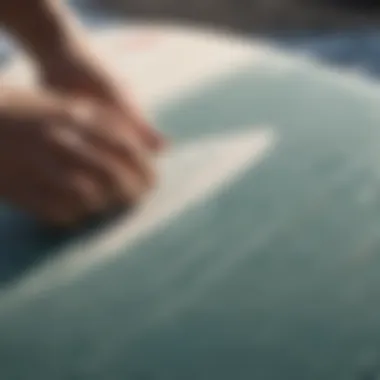Maximize Surf Performance with Basecoat Surf Wax


Intro
An essential aspect of enhancing one’s surfing experience hinges on the quality and application of basecoat surf wax. While many surfers may prioritize board shapes or skill enhancements, the right wax plays a vital role in achieving optimal performance on the waves. This article digs deep into the significance of basecoat surf wax, exploring how it can elevate your surf game from merely decent to consistently exceptional.
When you’re out there riding the waves, grip is everything. The basecoat acts as a foundation, ensuring that your feet stay secured, whether you’re paddling out or executing that perfect turn. The art of waxing, however, goes beyond just slapping on some wax. This guide will cover not only application techniques but also delve into the different formulations of wax that can suit various surfing conditions.
Expect to uncover insights on:
- Surfing Techniques: Tips for everyone, from novices to seasoned pros.
- Surfboard Selection: How to choose and maintain your board, so you maximize performance.
- Environmental Considerations: Sustainable surf wax choices that are kind to our oceans.
Being equipped with in-depth knowledge about basecoat surf wax can empower surfers of all skill levels to make informed choices. Let's dive right in.
Preamble to Surf Wax
Surf wax might seem like an afterthought for some, but for those who truly understand its impact, it’s a fundamental component of the sport. It provides that critical grip needed atop your surfboard, keeping you from slipping into the sea like a fish out of water. When the stakes are high and waves are rolling, having the right surf wax can mean the difference between riding smoothly or tumbling unceremoniously into the depths.
Definition and Purpose
At its core, surf wax is a specially formulated substance that enhances traction between a surfer's feet and the board. Typically made from natural or synthetic waxes and additives, its primary goal is to create friction. Without it, surfers might find themselves skating out from under their feet on even the smallest of waves.
Surf wax comes in various types, tailored to different water temperatures and surf conditions, and they each serve a specific purpose:
- Basecoat Wax: This serves as the foundation that other wax layers adhere to.
- Topcoat Wax: This is applied on top for added grip in warmer waters.
Fun fact: some surfers even wax their boards before a session to ensure optimal conditions, almost like putting on performance-enhancing shoes.
Historical Context
Surfing has roots that trace back thousands of years, so it’s no surprise that surf wax has an equally rich history. In Hawaii, ancient surfers used natural resins and materials as makeshift wax to grip their boards. As the sport spread globally, so did the need for improved grip solutions.
By the 20th century, surf wax began to evolve with advancements in chemistry. The introduction of synthetic formulations led to a boom in the variety of wax available. Today’s formulations are often loaded with secret ingredients that surfers swear by, each boasting unique properties depending on climatic conditions and individual preferences.
Understanding the historical context not only showcases the evolution of the sport but also emphasizes the importance of surf wax in surf culture. It’s more than just a substance—it’s a tool that has been refined through years of practice, innovation, and community knowledge.
Understanding Basecoat Surf Wax
Basecoat surf wax plays a pivotal role in the surfing experience, acting as the unsung hero behind a surfer’s ability to maintain grip and control on their board. While many might underestimate its significance, understanding basecoat surf wax can elevate one’s performance on the waves and ensure that each ride is as smooth as possible. Delving into its nature helps surfers, whether they are roping in their first wave or tackling a beast of a swell, fully appreciate how this humble product makes a noticeable difference in handling a board.
What is Basecoat Wax?
Basecoat wax is the first layer applied to a surfboard, functioning primarily as a base for subsequent layers of wax. More than just a simple substance, it creates a rough texture crucial for traction. It’s like laying the foundation of a house—without a solid base, how can you expect the rest to stand tall? Typically, basecoat wax is harder compared to topcoat wax, which is softer and meant to provide additional grip.
Specifying its function further, basecoat wax works hand-in-glove with the topcoat. The interplay between the two layers creates optimal stickiness; surfers can carve and maneuver their boards without fear of slipping off. Moreover, understanding which type of basecoat fits your surfing style can help ensure you maximize the efficiency of the grip your wax can provide.
Composition and Ingredients
The composition of basecoat wax is where things get interesting. Generally, it consists of a blend of paraffin, beeswax, and natural resins. The quality of these ingredients can vary considerably from brand to brand.
- Paraffin: A commonly used base in wax for its affordability and availability. It gives a firmer texture, aiding in establishing a solid grip.
- Beeswax: This ingredient provides more flexibility. It helps the wax stick to the board, enhancing the overall grip as it allows some expansion when the board heats up in warmer water.
- Natural Resins: Often included for added tackiness. Resins can come from various sources, each affecting the wax's grip differently.
When blended correctly, these components create a wax that adheres well to different board materials, enabling surfers to unleash their potential on the waves.
"Using the right basecoat can mean the difference between surfing with confidence and struggling on your board."
It's also worth noting the variety of formulas targeted for specific conditions or board materials, illustrating the diversity of products available.
In summary, the heart of basecoat wax lies in understanding its profound influence on surfing experience. By comprehending what it is and its components, surfers can make informed choices that enhance their grip and overall performance on the waves.


The Application Process
When it comes to getting the most out of surf wax, applying it correctly is as crucial as selecting the right type for your needs. The application process can make or break your experience in the water. Proper technique enhances grip and protects your surfboard from the elements while optimizing your performance. Understanding how to prepare your surfboard, layer your wax thoughtfully, and avoid common mistakes will elevate your surfing to new heights.
Preparing Your Surfboard
Before slapping on some wax, it's important to make sure your surfboard is ready. That doesn't just mean giving it a quick wipe with a cloth. You need to properly clean the board's surface to ensure that whatever wax you apply sticks well, providing maximum traction. Dirty or residual wax will mess with your grip.
- Clean the Board: Use a wax comb or scraper to remove any old wax. Make sure to get into the edges and nook, where debris often hides.
- Rinse and Dry: After scraping, rinse the board with fresh water to eliminate dust or sand left over from your last surf session. Dry it with a clean towel before moving to the wax application.
- Check for Dings: Assess your board for any dings or damages. Small cracks can affect how the wax adheres and might spoil your fun in the water if left unchecked.
Layering Techniques
Applying wax isn’t just about slapping it on; it’s more like an art form. The way you layer your wax greatly influences how it performs across varying surf conditions.
- Go Basecoat First: Apply a good layer of basecoat wax first. This helps create a solid foundation by providing a stable grip.
- Circular Motion: Use a circular motion when applying to ensure an even spread. Think of it as drawing little circles with the wax stick. Don’t be stingy; the more you layer, the more grip you will have.
- Crosshatch Method: After the basecoat, apply the topcoat. Try the crosshatch technique—apply the topcoat at an angle across the basecoat to form a grid. This creates a more textured surface and improves traction.
By using these methods, you’ll find that your board ‘feels’ more secure beneath your feet, which is exactly what you want when catching a big wave!
Common Mistakes to Avoid
Even seasoned surfers aren’t immune to errors in the application process. Identifying and rectifying these pitfalls keeps your surf sessions enjoyable and effective. Here are some blunders to sidestep:
- Skipping Cleaning: Neglecting to clean your board thoroughly can easily lead to subpar performance.
- Applying Too Much Wax: Very thick layers can actually impede grip. Remember, it needs to be functional, not fluffy.
- Using the Wrong Wax: Choosing a wax that’s not suited for your surf conditions—like using warm water wax in cold conditions—can leave you slipping.
- Ignoring Temperature Changes: Wax can soften in warm temperatures and become firm in cold water. Adjust your wax types according to your surfing locale.
"A well-prepped board is half the battle won. Waxing is an essential part of gear maintenance that may seem trivial, but it directly impacts overall surfing performance."
With these insights in mind, you can avoid rookie mistakes and harness the full potential of your surf wax application. The right process not only boosts your grip but also cultivates confidence as you ride those waves.
Benefits of Using Basecoat Surf Wax
When it comes to surfing, the difference between catching the perfect wave and tumbling in the whitewash often boils down to something as seemingly simple as wax. With basecoat surf wax, the advantages extend beyond just a better grip; it’s about enhancing overall performance on the water. In this section, we’ll explore the myriad benefits of using basecoat wax, focusing on how it can improve your surfing experience.
Enhanced Grip
Firstly, grip is paramount for any surfer. Basecoat wax offers an impressive hold that allows surfers to feel secure on their boards. This added traction helps prevent slips, especially during paddling and take-off, which are critical moments in riding. The energy of a wave can be relentless, and one wrong move can lead to a wipeout.
With basecoat wax, surfers can feel confident knowing their feet will stick to the board when it counts.
Another thing to consider is the formulation of the wax. Most basecoat waxes have a specific texture that enhances grip without feeling overly sticky or tacky. Surfers usually find that they're able to maneuver with more precision, making cuts and turns sharper and more controlled. This improved grip is like having a secret weapon—ensuring you can focus more on the wave ahead and less on staying balanced.
"The right wax can keep you on your board, even when the waves are at their most challenging."
Increased Durability
Durability is another significant benefit of using basecoat surf wax. Unlike topcoat waxes, which are often softer and designed to offer immediate grip, basecoat wax is generally more resilient for long-term use. When you lay on a good layer of basecoat, it can withstand the wear and tear of multiple sessions in the water.
This means fewer reapplications, allowing surfers to spend more time riding instead of waxing. Think about it: in a single surf session, if your wax can last longer, you can focus on the ride without the hassle of constantly checking and reapplying.
Durability doesn’t just protect the wax itself; it also preserves the topcoat. Applying a solid basecoat can enhance the lifespan of the top layer, ensuring your grip doesn’t wear off after just a few waves. Additionally, a durable application is beneficial when surfing in rougher conditions where the board may be more susceptible to dings and scratches.
Performance in Various Conditions
The weather and oceanic conditions can vary greatly, and basecoat surf wax is versatile enough to handle them all, from tropical heat to polar chills. For instance, a quality basecoat wax can maintain its grip even in warm waters, where other types might soften and smear off easily. That means if you hit a sun-soaked beach, you’re still going to find more stickiness under your feet.
Conversely, when navigating cold waters, a solid basecoat can help the wax stay firm and provide consistent traction, even when the chill tries to break things down.
Also, wave types play a role here. From mellow waves to powerful breaks, having a strong base can change how well your performance fares. So, whether you're surfing in small beach breaks or tackling big swell, basecoat surf wax ensures you're set up for success no matter what you encounter.
In summary, investing in basecoat surf wax offers benefits that are far-reaching. It enhances grip, boosts durability, and adapts to various surfing conditions, catering to the diverse needs of surfers everywhere. For those looking to take their surf performance to the next level, basecoat wax shouldn't just be an option but rather an essential part of your surf gear.
Comparing Basecoat Wax with Other Types
When it comes to surf wax, knowing the differences between the various types is key for any surfer aiming to maximize their performance. Basecoat wax stands as a foundational element in the wheelhouse of surf wax, acting as a crucial link between the surfboard and the topcoat. What is often missed is the nuanced interplay between these wax types, which can significantly influence grip and durability in the water. Understanding these contrasts helps surfers make informed decisions suited to their specific surfing conditions.


Basecoat vs. Topcoat Wax
Basecoat wax is like the unsung hero of the surfing world. It provides a solid foundation, acting as a sticky base layer that enhances overall traction when paired with topcoat wax. Essential for maintaining grip, it ensures that the topcoat wax sticks properly to the board. Remember, a proper application of basecoat does not just help hold the topcoat in place, but also can improve the interaction between the board and the waves.
In contrast, topcoat wax serves as the finishing touch, often designed for specific temperature and water conditions. It delivers optimal grip and flexibility, reacting better to the situation at hand. Each has its own intended use:
- Basecoat Wax:
- Topcoat Wax:
- Supplies a tacky base layer.
- Helps in preventing slippage when paddling or riding.
- Acts as a bonding agent for topcoat wax.
- Adjusts grip levels based on temperature or water condition.
- Designed for specific surf situations.
- Easily replaced without changing the basecoat.
Selecting the correct wax combination can make a world of difference. For warm water surfing, using a softer topcoat atop a solid basecoat can elevate performance. Conversely, in chilly waters, a firmer topcoat on a basecoat can provide needed traction without compromising stability.
Hard Wax vs. Soft Wax
The debate over hard wax versus soft wax is a classic topic among surfers. Hard wax is often favored for its longevity and ability to withstand extreme conditions, making it a reliable choice for those tackling heavy waves. Many surfers appreciate how hard wax holds up against longer surf sessions, sometimes needing less frequent reapplication.
On the other hand, soft wax has the advantage when it comes to the ease of application and adjustments in varying conditions. Soft wax, often preferred in warmer waters, provides the flexibility a surfer may need for quick maneuvers. Its grip tends to mold well with the contours of the board, giving an excellent feel when navigating through waves.
Each type has its unique strengths:
- Hard Wax:
- Soft Wax:
- Ideal for durability and harsh conditions.
- Long-lasting, requiring less frequent application.
- Can create a slick surface if not applied properly.
- Well-suited for warmer climates and temperatures.
- Excellent for producing a secure feel on the board.
- May require more frequent reapplying compared to hard wax.
In summary, understanding these key differences between basecoat and other wax types empowers surfers to tailor their equipment to suit their specific surfing needs, ensuring optimal performance while enjoying the waves.
"The right choice of wax can transform your surf experience—don't underestimate the small details!"
By experimenting with different combinations of basecoat, topcoat, hard, and soft wax, surfers can discover what works best for them, adapting continuously to the diverse demands of surf conditions.
Special Considerations for Different Surf Conditions
When choosing wax for your surfboard, factors such as water temperature and wave types play a crucial role in your surfing performance. It’s not just about slapping on any old basecoat and hoping for the best. Surfers need to think about how different surf conditions may impact their grip and overall ride. Tailoring your wax choice to specific conditions can vastly improve not just performance but also comfort on the water.
Warm Water vs. Cold Water Wax
Using the right wax for the water temperature is paramount. Warm water wax generally has a softer consistency, designed to work effectively in higher temperatures. You wouldn’t want to be riding in T-shirts and shorts with a hard wax designed for snowy conditions. Conversely, cold water wax is harder, providing the necessary grip in cooler waters where you might find yourself wearing a wetsuit.
- Soft Wax (Warm Water): Works best in temperatures above 70°F (around 21°C). It tends to melt more easily, giving you that sticky hold needed to keep your balance on those hot summer days.
- Hard Wax (Cold Water): Ideal for temperatures below 70°F. The firmer composition prevents it from getting too sloppy, ensuring that it stays intact while providing necessary grip even in chilly seas.
While it might be tempting to skimp on the wax selection, consider how a poor choice can detract from your surfing experience. The right wax not only enhances your grip but also adds to your confidence, allowing you to focus more on the waves.
Choosing Wax for Various Wave Types
Different wave types can also dictate your wax choice. Beach breaks may call for a different formula compared to reef breaks or point breaks. Here’s a breakdown of what to keep in mind:
- Beach Breaks: Typically consist of unpredictable waves that can shift rapidly. A medium soft wax could be beneficial here, as it aids in maintaining grip while still allowing for quick movements when needed.
- Reef Breaks: These can be more consistent but may involve sharper, faster waves. Hard wax could work better, providing a stable grip for strong cuts and powerful turns.
- Point Breaks: With smooth, long rides, optimal edge control is necessary. A combination of a soft basecoat with a tacky top layer may be worth considering to maximize performance and maneuverability.
Using the right type of wax for your wave conditions not only leads to better rides but minimizes the chances of wipeouts—something every surfer can appreciate.
"The right wax can mean the difference between an exhilarating ride and a frustrating fall. Choose wisely!"
By understanding these nuances, surfers can better prepare for the ocean’s challenges, crafting a more personalized and effective approach to surf wax. The payoff is unmistakable: a more enjoyable and successful ride every time you hit the waves.


Environmental Considerations
The topic of environmental considerations is an increasingly critical conversation in the surfing community. With growing awareness of the effects human activities have on the ocean, it is important to take a closer look at how surf wax can impact marine ecosystems. Not only do surfers want to maximize their performance, but they also need to think about the well-being of the waters they enjoy.
Impact of Surf Wax on Marine Life
Many surfers might not realize that the wax they apply to their boards can have unfortunate repercussions for marine life. Typically, surf wax contains hydrocarbons and synthetic substances that may drip off during use. This runoff can ultimately find its way into the ocean, affecting the delicate balance of the ecosystem. Fish, coral, and several other creatures might suffer the consequences of these pollutants, which can disrupt their habitats and reproductive cycles.
"The world is our playground, but that playground has boundaries. We must be stewards of our oceans."
The chemicals in conventional surf wax can lead to bioaccumulation, which occurs when toxic substances build up in the bodies of marine animals. This can create a domino effect up the food chain, threatening species and ultimately impacting human health as well. In broader terms, awareness of our choices can lead to meaningful changes—both in our individual practices and in industry standards that prioritize responsible formulation of surf products.
Sustainable Alternatives
Fortunately, there are ways to enjoy surfing without contributing to environmental degradation. There’s a growing market for eco-friendly surf wax products that strive to minimize environmental impact while maintaining performance. Materials like plant-based waxes are being developed, providing a viable alternative to traditional surf wax.
When choosing a sustainable wax, consider the following:
- Biodegradability: Can the product naturally break down without harming marine life?
- Ingredients: Are there harmful chemicals in the formulation?
- Packaging: Is it recyclable or made from sustainable sources?
Some surf brands highlight their commitment to sustainability, making it easier for surfers to choose the right product. Using biodegradable wax not only benefits the environment but also often yields better performance and grip compared to conventional options.
Additionally, attempting to minimize unnecessary waste during application and disposal of wax through responsible habits can go a long way. By opting for sustainable alternatives, surfers can protect ocean life while still engaging in the sport they love. Taking these steps creates a positive ripple effect, showing that care for the environment can coexist with passion for surfing.
Maintaining Waxed Surfboards
Keeping your surfboard properly waxed is a critical component of ensuring high performance in the water. Surf wax, especially basecoat, is not just an add-on; it fundamentally influences your grip, maneuverability, and overall ride. Overlooking maintenance can lead to diminished performance and could even impact safety while surfing.
Regularly maintaining your waxed surfboard helps to ensure you can ride the waves effectively in various conditions. It also helps prolong the life of your board’s surface as well as the wax. Think about it this way: just like a car needs regular service to run smoothly, your surfboard needs its wax maintained to execute the high stakes turns and drops smoothly.
Routine Maintenance Tips
Maintaining your surfboard's wax isn't about a whole rigmarole. In fact, making a habit of simple practices can make a huge difference:
- Clean the Surface Regularly: After a session, rinse the board with fresh water. Saltwater can degrade wax quality over time, leading to slippiness.
- Inspect for Wax Buildup: If you notice your wax getting chunky or crumbly, scrape it off gently. Don't be too rough though; you don’t want to damage the board underneath.
- Reapply New Basecoat: Every few sessions, add a new layer of basecoat wax. This isn’t just about grip; a fresh layer can revive the overall feel when paddling and catching waves.
- Consider the Temperature: Different surf conditions or seasons may require specific types of wax. Warmer wax in summer and cooler wax during winter can improve performance.
These simple habits keep your surfboard primed and ready for anything the ocean throws your way!
When to Reapply Wax
Knowing when to reapply wax can be an art in itself, but fortunately, there are a few signs to guide you:
- Significant Wear or Tear: If your wax shows signs of peeling or just feels flat, it’s time to refresh it. You want a solid texture that provides traction but still remains flexible.
- After Long Breaks: If you haven’t touched your surfboard in a while, it’s usually wise to give it a new coat. Dust and environmental factors can affect the wax’s integrity.
- Before Major Surf Trips: Heading out to surf at a new location? A fresh coat means you’ll start off with optimal performance, no matter the unknown conditions.
- Surface Feel: If it starts to feel slippery or less grippy than usual while paddling out or popping up, that’s a clear indicator that you're due for a reapplication.
The timing of your reapplications will depend heavily on your surfing frequency and the environment you’re riding in.
Remember: A well-waxed board equals a happier surfer. Paying attention to these maintenance details could translate into better performance on the water and significantly enhance your overall experience.
Culmination and Recommendations
As we wrap up this guide on basecoat surf wax, it becomes glaringly clear just how integral it is to enhancing surf performance. By grasping the nuances of waxing techniques and selecting the right type of wax for specific conditions, surfers can significantly elevate their riding experience. The implications of using the proper basecoat wax extend beyond just personal performance; it speaks to a larger commitment to preserving the surf environment.
One of the key elements we discussed is the importance of regularly maintaining your waxed surfboard. Wax can wear off due to various factors like exposure to sunlight or frequent use in harsh conditions. Maintaining a routine can not only enhance grip but also prolong the lifespan of your surfboard. Reapplying wax at opportune moments ensures that you're always ready to hit the waves without concerns of slipping or losing balance. Moreover, being diligent about upkeep fosters a deeper connection with your equipment, allowing you to better understand how its performance changes according to different variables.
The environmental impact of surf wax is another vital consideration. Surfers have increasingly become conscious of what their sport means for marine ecosystems. Sustainable alternatives to traditional wax formulas are now available, and it's worth taking the time to explore these options. Opting for eco-friendly waxes can help preserve the waters that we cherish and utilize.
In summary, informed decision-making about basecoat surf wax is essential. Understanding its composition, applying it correctly, and regularly maintaining it can unlock a world of benefits for every surfer. By making well-considered choices, from the wax type to insightful maintenance practices, surfers can not only enhance their performance but also contribute positively to the environment they so passionately enjoy.
Key Takeaways
- Proper Maintenance is Crucial: Regularly refresh your wax to ensure optimal grip and performance.
- Understand Wax Types: Different wax compositions serve unique purposes—learn which suits your style and circumstances best.
- Consider Environmental Effects: Explore sustainable options to lessen your impact on marine life.
- Layering Matters: Apply both basecoat and topcoat wisely to maximize grip on your surfboard.
Final Thoughts
As surfers, our connection to the ocean runs deep, and so does our responsibility to protect it. The right basecoat surf wax can transform your performance while keeping your conscience clear when it comes to environmental stewardship. Embracing the essentials laid out in this guide means not just enhanced surfing experiences but also a commitment to preserving the beauty of the ocean. Each time you hit the waves, remember that your choices—from gear to techniques—play a pivotal role in both your performance and the planet's health. Happy surfing!



